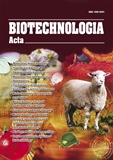ISSN 2410-7751 (Print)
ISSN 2410-776X (Online)

Biotechnologia Acta Т. 18, No. 2, 2025
P. 74-78, Bibliography 16 , Engl.
UDC 616-006.6:577.2-085
doi: https://doi.org/10.15407/biotech18.02.074
The Anticancer Effect of RAD51-IN-1 in MDAH-2774 (CVCL_0420) Cells
Deniz ÖZDEMİR, Can Ali AĞCA
Department of Molecular Biology and Genetics, Bingöl University, 12000, Bingöl, TÜRKİYE
Aim. This study aimed to investigate the effect of pharmacological inhibition of RAD51, via RAD51-IN-1, on the MDAH-2774 cell line.
Methods. To achieve these objectives, firstly, MDAH-2774 cells were treated with different doses of RAD51-IN-1 to determine the effects on cell viability and the IC50 value of RAD51-IN-1. Intracellular ROS levels of the cells were investigated by DCFDA staining and their migration abilities were examined by wound healing test. In the last set of experiments, the effect of RAD51-IN-1 monotherapy application on cell death was investigated by acridine orange/ethidium bromide staining.
Results. In the experimental findings obtained, firstly, cells were treated with different doses of RAD51-IN-1 to decrease cell viability and IC50 of RAD51-IN-1 was determined. In addition, it was observed that the amount of intracellular ROS increased after DCFDA staining after RAD51-IN-1 treatment. In the last set of experiments, it was determined that cell death occurred with increasing doses following acridine orange/ethidium bromide staining of RAD51-IN-1.
Conclusion. The RAD51-IN-1 small molecule inhibitor is a promising approach for treating ovarian cancer, but the drug requires further in vitro evaluation.
Keywords: Ovarian Cancer, RAD51-IN-1, ROS, Cell Death.
© Palladin Institute of Biochemistry of the National Academy of Sciences of Ukraine, 2025
References
1. Tew, B. Y. (2023). ATM-Inhibitor AZD1390 Is a Radiosensitizer for Breast Cancer CNS
Metastasis.,” Clin. cancer Res. an Off. J. Am. Assoc. Cancer Res., 29 (21), 4492–4503. https://doi.
org/10.1158/1078-0432.CCR-23-0290 https://doi.org/10.1158/1078-0432.c.6908259
2. Huang, R. X., Zhou, P. K. (2020). “DNA damage response signaling pathways and targets
for radiotherapy sensitization in cancer,” Signal Transduct. Target. Ther., 5(1) https://doi.
org/10.1038/s41392-020-0150-x
3. Alizzi, Z., Saravi, S., Khalique, S. McDonald, T., Karteris, E., Hall, M. (2023). Identification of
RAD51 foci in cancer-associated circulating cells of patients with high-grade serous ovarian cancer:
association with treatment outcomes. Int. J. Gynecol. cancer Off. J. Int. Gynecol. Cancer Soc., 33(9),
1427–1433. https://doi.org/10.1136/ijgc-2023-004483
4. Holthausen, J., Wyman, T. C., Kanaar, R. (2010). Regulation of DNA strand exchange in
homologous recombination. DNA Repair (Amst)., 9(12), 1264–1272. https://doi.org/10.1016/j.
dnarep.2010.09.014
5. Feng, Y. Wang, D., Xiong, D. L., Zhen, G., Tan, J. (2021). Predictive value of RAD51 on the
survival and drug responsiveness of ovarian cancer. Cancer Cell Int., 21(1), 249. https://doi.
org/10.1016/j.dnarep.2010.09.014
6. Nagathihalli, N. S., Nagaraju, G. (2011). RAD51 as a potential biomarker and therapeutic target
for pancreatic cancer. Biochim. Biophys. Acta — Rev. Cancer. ,1816(2), 209–218. https://doi.
org/10.1016/j.bbcan.2011.07.004
7. Song, J. (2021). Overexpression of HMGA1 confers radioresistance by transactivating RAD51 in
cholangiocarcinoma. Cell Death Discov., 7(1), 322. https://doi.org/10.1038/s41420-021-00721-8
8. Xu,Y., Chen, K., Cai, Y., Cheng, C., Zhang,Z., Xu, G. (2019). Overexpression of Rad51 predicts
poor prognosis and silencing of Rad51 increases chemo-sensitivity to doxorubicin in neuroblastoma.
Am. J. Transl. Res., 11(9), 5788.
9. Clin, A. (2020). RAD51 Inhibitor Reverses Etoposide-Induced Genomic Toxicity and Instability
in Esophageal Adenocarcinoma Cells. Arch. Clin. Toxicol., 2(1), 3–9. https://doi.org/10.46439/
toxicology.2.006
10. Alagpulinsa, D., Ayyadevara, A. S., Shmookler Reis, R. J. (2014). A small molecule inhibitor of
RAD51 reduces homologous recombination and sensitizes multiple myeloma cells to doxorubicin.
Front. Oncol., 4, 1–11, https://doi.org/10.3389/fonc.2014.00289
11. Ward, A. (2017). Quinazolinone derivatives as inhibitors of homologous recombinase RAD51.
Bioorg. Med. Chem. Lett., 27(14), 3096–3100. https://doi.org/10.1016/j.bmcl.2017.05.039
12. Doğan, A. A. Doğan, N. C. (2022). Investigation of the effects of sodium phenylpyruvate on
pulmonary adenocarcinoma (A549) and mammary adenocarcinoma (MDA-MB-231) on cell lines.
Cauc. J. Sci., 9(1), 20–34. https://doi.org/10.48138/cjo.979147

